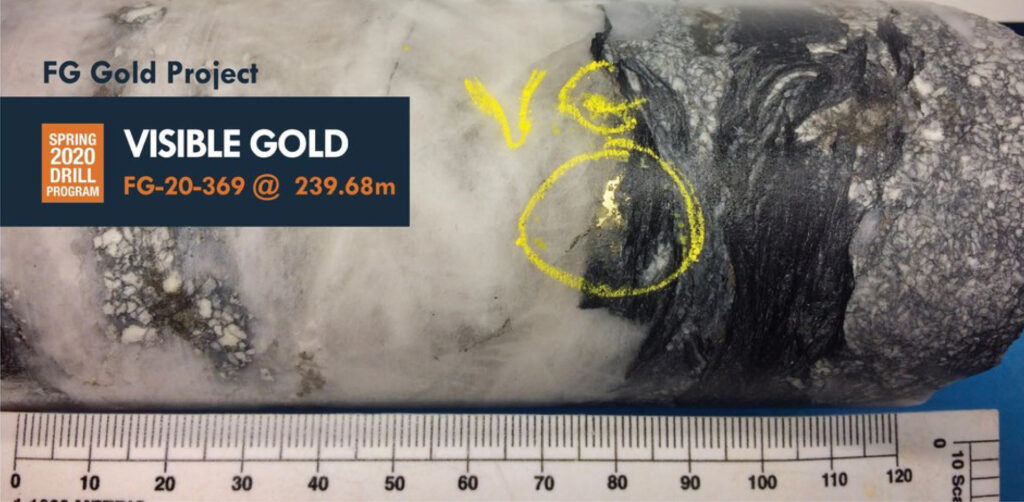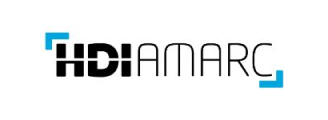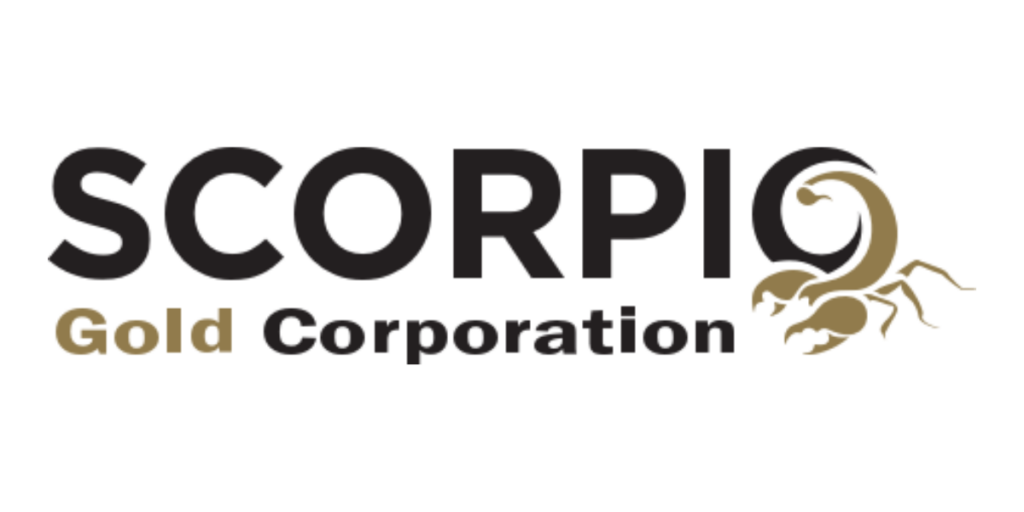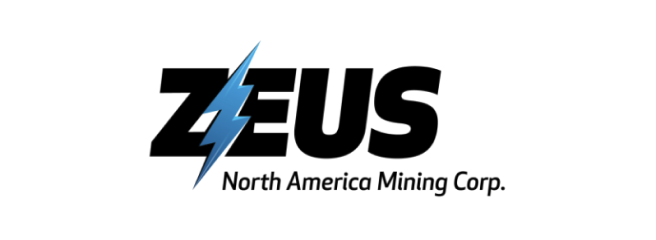VANCOUVER, BC, June 10, 2020 /CNW/ – KORE Mining Ltd. (TSXV: KORE) (OTCQB: KOREF) (“KORE” or the “Company“) is pleased to announce drill hole FG-20-369 intercepted 32 meters of 3.0 g/t gold starting at 22 meters and discovered a new zone with 10 meters of 3.9 g/t gold starting at 237 meters at the FG Gold Project (“Project” or “FG Gold”) in the Cariboo Region of British Columbia.
Due to the results to date, the Company is preparing to commence an extended drilling program to further delineate the existing resource and test on-strike and downdip extensions.
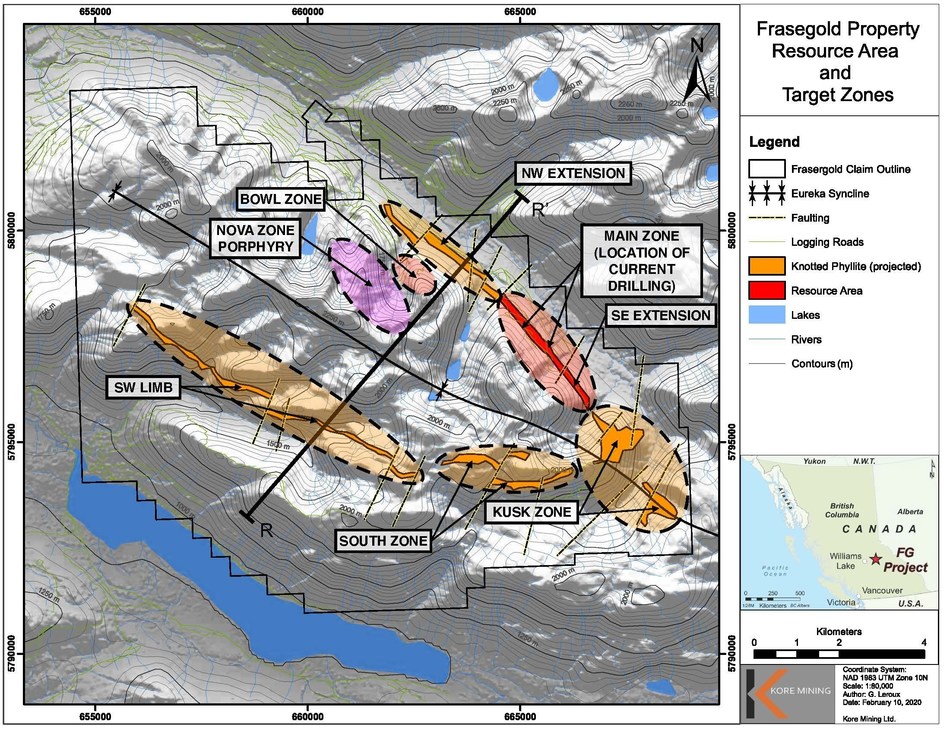
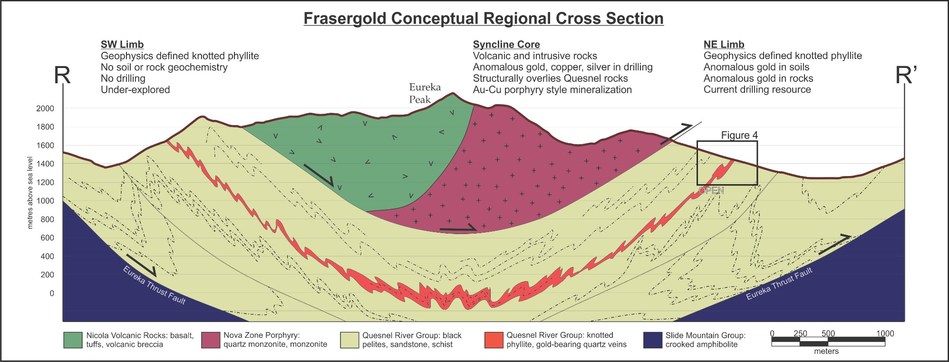
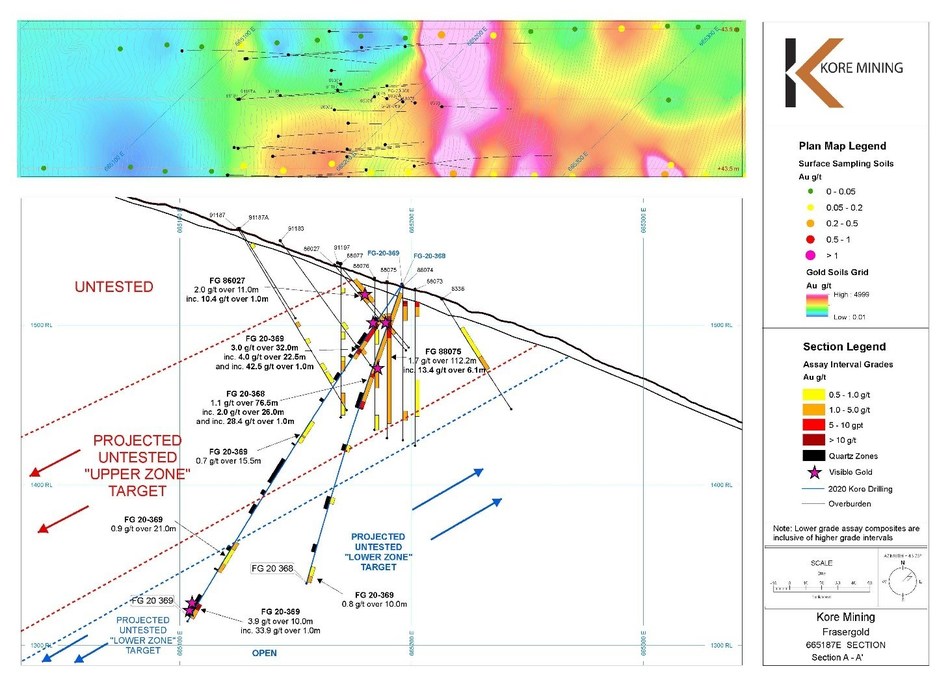
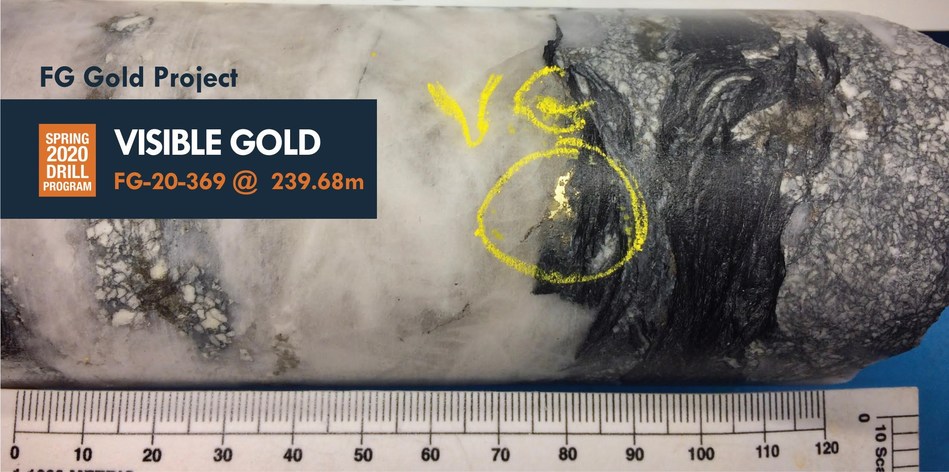

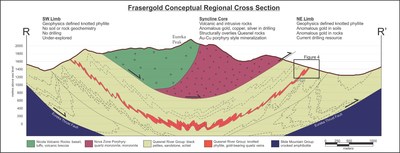
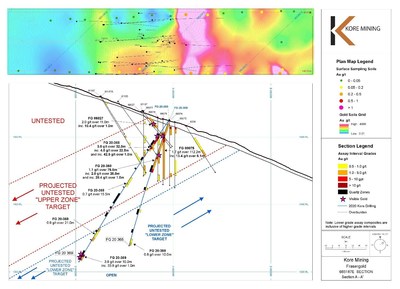
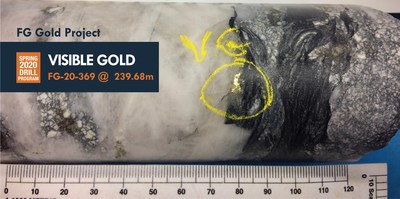
Highlights
- Lower Zone discovery: 10 meters of 3.9 g/t gold starting at 237 meters in FG-20-369 including:
- 1.0 meter of 33.9 g/t at 239.0 meters
- Hole FG-20-368 hit 10 meters of 0.8 g/t at 185 meters in same zone
- New Lower Zone thickness remains open
- Upper Zone intercept: 32.0 meters of 3.0 g/t gold starting at 22.0 meters in FG-20-369 including:
- 1.0 meter of 42.5 g/t at 29.0 meters
- Large diameter, oriented core and metallic screen assays have upgraded past drilling
- Gold intercepts of 28.4 g/t, 42.5 g/t, and 33.9 g/t (1.0 meter) are all higher grade than any intersections in previous 11 holes drilled in this section
- Previous 11 holes had three metallic screen assays; KORE conducted over 150 metallic screen assays on 2 holes
- Metallic screen assays upgraded traditional fire assays over 5.0 g/t by an average of 48%
- Mineralization remains open at depth and along almost the entire 20-kilometer trend representing a district scale exploration opportunity for further discovery and resource expansion
Eight large diameter (HQ) oriented core drill holes for a total of 1,577 meters were completed in April 2020. Assays from the first two holes are included in this news release. The remaining holes FG-20-370 to FG-20-375 (metallic screen assays pending) all intercepted zones of quartz veining, within the existing resource and newly identified quartz veins below the existing resource. The remaining holes assess both the “upper zone” and newly discovered “lower zone” in a similar manner as FG-368/69 assessed the section discussed in this release.
The full table of results are included below. Detailed core logs and photos are available at: www.koremining.com/exploration-highlights.
KORE CEO Scott Trebilcock commented, “Seeing high grade intercepts associated with visible gold in the core, validates our excitement about the FG Gold project. With the discovery in the Lower Zone, high core recovery to define structure and metallic screens upgrading assays, we are hitting all our objectives and will continue drilling after spring breakup later in June.”
The 20-kilometer trend is defined by gold in soils and geophysics that traces the mineralized rock group around the regional syncline. The Project has only been shallowly drilled where the mineralized rock group comes to surface. Past drilling averages only 93 meters deep into a low to moderately plunging sedimentary host rock. Mineralization is open at depth and along almost the entire trend. Figure 2 is a regional cross-section that shows the host rock potential at depth and connection to a potential porphyritic intrusion.
Due to coarse visible gold, metallic screening assays provide a much more representative sample versus conventional fire assays. Historical drilling and assays had limited and sporadic metallic screen analyses which may have underestimated historical gold grades.
Details of Core Holes FG-20-368 and FG-20-369
Hole FG-20-368 was targeting the structural controls for known mineralization, and looking to extend the mineralization down the host rock structure. Hole FG-20-368 encountered seven quartz vein intervals with assays compiled in tables below.
Hole FG-20-369 was drilled as a scissor hole from the same pad and also encountered quartz veining and two incidences of coarse visible gold (see Figure 4). A cross section of the two holes is presented as Figure 3. FG-20-369 intercepted 13 quartz veins between 5.5 and 250 meters down-hole which tested an additional 100 meters below the previous resource. A total of ten quartz vein intercepts in FG-20-368 and FG-20-369 were encountered below the depth of historic drilling.
Holes 368 and 369 were started below the hanging wall of the “upper zone”. As additional holes are drilled in this section, they will be drilled through the entirety of the “upper zone” while exploring both the thickness of the “lower zone” and downdip extension of both zones.
As more assay data comes in KORE will be conducting structural analysis and interpretation.
Hole FG-20-368
Top 110 meters of assays previously released May 19, 2020 and set again below including the latest data:
|
From |
To |
Width* |
Gold (g/t) |
Zone |
|
|
Intercept |
5.5 |
82.0 |
76.5 |
1.1 |
Upper |
|
including |
5.5 |
18.0 |
12.5 |
1.2 |
|
|
including |
27.0 |
35.0 |
8.0 |
1.6 |
|
|
including |
56.0 |
82.0 |
26.0 |
2.0 |
|
|
and including |
81.0 |
82.0 |
1.0 |
28.4 |
|
|
and |
106.0 |
110.0 |
4.0 |
0.6 |
Upper |
|
and (new) |
185.0 |
195.0 |
10.0 |
0.8 |
Lower |
Hole FG-20-369
|
From |
To |
Width* |
Gold (g/t) |
Zone |
|
|
Intercept |
22.0 |
54.0 |
32.0 |
3.0 |
Upper |
|
including |
29.0 |
51.5 |
22.5 |
4.0 |
|
|
including |
29.0 |
30.0 |
1.0 |
42.5 |
|
|
and |
102.5 |
118.0 |
15.5 |
0.7 |
Upper |
|
and |
192.5 |
213.5 |
21.0 |
0.9 |
Lower |
|
and |
237.0 |
247.0 |
10.0 |
3.9 |
Lower |
|
including |
239.0 |
240.0 |
1.0 |
33.9 |
* True widths are unknown at this time and will be updated when full review and interpretation of oriented core measurements has been completed
Details of Metallic Screen Assaying
Metallic screen assays are often used in exploration when coarse or visible gold is present in the core as we have here at the FG Gold Project. Traditionally, fire assays are undertaken on 30-50 grams of pulverised sample. The metallic screen fire assay uses a larger sample (1 kilogram in our case), with screening (to -106 micron) to separate coarse gold particles from fine material. After screening, two samples of the fine fraction are analysed using the traditional fire assay method. The fine fraction is expected to be reasonably homogenous. The entire coarse fraction is assayed to determine the contribution of the coarse gold. This method helps reduce the erratic assay results often seen in the higher-grade zones found in “nuggety” gold deposits such as the FG Gold Project. All assays are performed at accredited independent commercial assay labs.
At the FG Gold Project, the results demonstrate an increase in gold grade using metallic screen assays in all grade ranges, especially above 1.0 g/t. Of the 9 samples traditional fire assaying higher than 5.0 g/t, metallic screening increased the grade of these assays by 48%, on average. Of the 31 samples traditional fire assaying between 1.0 g/t and 5.0 g/t, metallic screening increased the grade of these assays by 16% on average. Of the 42 samples assaying between 0.5 g/t and 1.0 g/t, metallic screening increased the grade of these assays by 10% on average. Of the 45 samples assaying between 0.3 g/t and 0.5 g/t, metallic screening increased the grade of these assays by 1% on average. These initial results indicate that upgrading of the fire assay results by metallic screen is an effective tool for assaying intervals above the currently used cut-off grade of the deposit (0.5 g/t).
Regional Geology
The FG Gold property straddles the boundary between the Omineca and Intermontane tectonics belts of the Canadian Cordillera. The eastward emplacement of the Intermontane Belt onto the Omineca Belt along the Eureka Thrust Fault caused widespread regional metamorphism and structural deformation of both Belts. The regional scale, northwest trending, shallowly plunging, Eureka Syncline is the dominant resulting structure in the project area. Rocks in the core of the Eureka Syncline are comprised of basalt, augite porphyry flows, tuffs and volcanic breccias metamorphosed to a low grade; they are structurally emplaced onto metavolcanic and sedimentary rocks of the Quesnel Terrane. The Quesnel Terrane is recognized for its prevalence of copper, gold and molybdenum mines and showings such as those at Highland Valley, Boss Mountain, QR and Mount Polley.
Property Geology
The FG Gold property is centrally located over the Eureka Syncline, strategically encompassing two limbs and the hinge zone of a gold-bearing meta-sedimentary rock unit of the Quesnel Terrane. The gold-bearing rock, a ‘knotted’ phyllite, is the host rock for gold mineralization over the 3 km strike length of the Resource Area (see Figure 1). Surface mapping and geophysical inversion of airborne electromagnetic (EM) data suggests the knotted phyllite has a strike length of over 20 km with potentially thickened regions occurring in the Eureka Syncline hinge zone (Kusk Zone Target) (see Figure 1).
Gold mineralization occurs in and is associated with development of quartz – Fe carbonate – muscovite – pyrite vein stockwork. The stockwork is best developed in the knotted phyllite unit. Stockwork zones locally concentrate in zones greater than 10 meters wide and are dominantly stratabound. Fe-carbonate alteration and carbonate porphyroblasts development within the knotted phyllite unit is observed to extend well outside immediate areas of veining.
About the FG Gold Project
The FG Gold project consists of 35 claims, totaling 13,008 ha, in the eastern Cariboo region of central British Columbia, approximately 100 km east of Williams Lake. The project is at low elevation and accessible by forestry roads. FG Gold hosts an orogenic gold deposit on the northeast limb of the Eureka syncline. The southwest limb and hinge zone are underexplored. The Project also hosts copper-gold porphyry mineralization at the Nova Zone, discovered by KORE in 2018. Figure 1 highlights the 20km trend of host rock expression at surface.
The 20-kilometer trend is defined by gold in soils and geophysics that traces the mineralized rock group around the regional syncline. The Project has only been shallowly drilled where the mineralized rock group comes to surface. Past drilling averages only 93 meters deep into a steeply plunging sedimentary host rock. Mineralization is open at depth and along almost the entire trend. Figure 2 is a regional cross-section that shows the host rock potential at depth and potential connection to the Project’s porphyritic intrusion.
The previous drilling targeted stratigraphic controls on mineralization and did not penetrate into the bulk of the host-rock structure. Drilling was largely done with RC and narrow core to generate shallow bulk-disseminated gold intercept models. Within the current resource there appear to be mineralized corridors or chutes that are open at depth in the host rock.
The current resource at the FG Gold project is as follows:
|
Classification |
Size (tonnes) |
Grade (g/t) |
Au (oz) |
Au Cutoff (g/t) |
|
Measured |
5,600,000 |
0.812 |
145,000 |
0.50 |
|
Indicated |
9,570,000 |
0.755 |
231,000 |
0.50 |
|
Inferred |
27,493,000 |
0.718 |
634,900 |
0.50 |
More information on the FG Gold Project and resource is available in the “NI 43-101 Technical Report, Frasergold Exploration Project, Cariboo Mining Division, BC” dated July 20, 2015 by K.V. Campbell of ERSi Earth Resource Surveys Inc. and G.H. Giroux of Giroux Consultants Ltd. technical report (“2015 Technical Report”) filed on www.sedar.com and on KORE’s website at www.koremining.com.
About KORE
KORE is 100% owner of a portfolio of advanced gold exploration and development assets in California and British Columbia. KORE is supported by strategic investors Eric Sprott and Macquarie Bank who, together with the management and Board own approximately 65% of the basic shares outstanding.
Further information on KORE and its assets can be found on the Company’s updated website at www.koremining.com and at www.sedar.com, or by contacting us as info@koremining.com or by telephone at (888) 407-5450.
On behalf of KORE Mining Ltd
“Scott Trebilcock”
Chief Executive Officer
(888) 407-5450
QA/QC and Qualified Person
Once the drill core was received from the drill site, individual samples were determined, logged for geological attributes, sawn in half, labelled, and bagged for assay submittal. The remaining drill core was then stored at a secure site in Horsefly, BC. The Company inserted quality control samples at regular intervals within the sample stream which included blanks, preparation duplicates, and standard reference materials with all sample shipments intended to monitor laboratory performance. Sample shipment was conducted under a chain of custody procedure.
Drill core samples were submitted to Bureau Veritas’ analytical facility in Vancouver, British Columbia for preparation and analysis. Sample preparation included drying and weighing the samples, crushing the entire sample, and pulverizing 250 grams. Analysis for gold was by method FA450: 50g fire assay fusion with atomic absorption (AAS) finish with a lower limit of 0.005 ppm and upper limit of 10 ppm. Gold assays greater than 10ppm are automatically analysed by method FA550: 50g fire assay fusion with a gravimetric fusion. Metallic screen techniques were employed to assay gold mineralized zones thought to contain coarse gold. Approximately 1000 grams of coarse reject material are pulverized and screened. Two splits of the fine fraction are assayed, as well as all material that does not pass through the screen (the coarse fraction). The final gold assay reported is a weighted average of the coarse and fine fractions.
Bureau Veritas is accredited to the ISO/IEC 17025 standard for gold assays, and all analytical methods include quality control materials at set frequencies with established data acceptance criteria. Parameters for Bureau Veritas’ internal and Kore’s external blind quality control samples were acceptable for the analyses returned.
Technical information with respect to the Project contained in this news release has been reviewed and approved by Marc Leduc, P.Eng, who is KORE’s COO and is the qualified person under National Instrument 43-101 responsible for the technical matters of this news release.
Neither the TSX Venture Exchange nor its Regulation Services Provider (as that term is defined in the policies of the TSX Venture Exchange) accepts responsibility for the adequacy or accuracy of this release.
Cautionary Statement Regarding Forward-Looking Information
This news release contains forward-looking statements relating to the future operations of the Company and other statements that are not historical facts. Forward-looking statements are often identified by terms such as “will”, “may”, “should”, “anticipate”, “expects” and similar expressions. All statements other than statements of historical fact, included in this release, including, without limitation, statements regarding the future plans and objectives of the Company are forward-looking statements. Such forward-looking statements, and any assumptions upon which they are based, are made in good faith and reflect our current judgment regarding the direction of our business. Management believes that these assumptions are reasonable. Forward looking information involves known and unknown risks, uncertainties and other factors which may cause the actual results, performance or achievements of the Company to be materially different from any future results, performance or achievements expressed or implied by the forward-looking information.
Such factors include, among others: risks related to exploration and development activities at the Company’s projects, and factors relating to whether or not mineralization extraction will be commercially viable; risks related to mining operations and the hazards and risks normally encountered in the exploration, development and production of minerals, such as unusual and unexpected geological formations, rock falls, seismic activity, flooding and other conditions involved in the extraction and removal of materials; uncertainties regarding regulatory matters, including obtaining permits and complying with laws and regulations governing exploration, development, production, taxes, labour standards, occupational health, waste disposal, toxic substances, land use, environmental protection, site safety and other matters, and the potential for existing laws and regulations to be amended or more stringently implemented by the relevant authorities; uncertainties regarding estimating mineral resources, which estimates may require revision (either up or down) based on actual production experience; risks relating to fluctuating metals prices and the ability to operate the Company’s projects at a profit in the event of declining metals prices and the need to reassess feasibility of a particular project that estimated resources will be recovered or that they will be recovered at the rates estimated; risks related to title to the Company’s properties, including the risk that the Company’s title may be challenged or impugned by third parties; the ability of the Company to access necessary resources, including mining equipment and crews, on a timely basis and at reasonable cost; competition within the mining industry for the discovery and acquisition of properties from other mining companies, many of which have greater financial, technical and other resources than the Company, for, among other things, the acquisition of mineral claims, leases and other mineral interests as well as for the recruitment and retention of qualified employees and other personnel; access to suitable infrastructure, such as roads, energy and water supplies in the vicinity of the Company’s properties; and risks related to the stage of the Company’s development, including risks relating to limited financial resources, limited availability of additional financing and potential dilution to existing shareholders; reliance on its management and key personnel; inability to obtain adequate or any insurance; exposure to litigation or similar claims; currently unprofitable operations; risks regarding the ability of the Company and its management to manage growth; and potential conflicts of interest.
In addition to the above summary, additional risks and uncertainties are described in the “Risks” section of the Company’s management discussion and analysis for the year ended December 31, 2019 prepared as of April 27, 2020 available under the Company’s issuer profile on www.sedar.com.
Forward-looking statements contained herein are made as of the date of this news release and the Company disclaims any obligation to update any forward-looking statements, whether as a result of new information, future events or results, except as may be required by applicable securities laws. There can be no assurance that forward-looking information will prove to be accurate, as actual results and future events could differ materially from those anticipated in such statements. Accordingly, readers should not place undue reliance on forward-looking information.
There is no certainty that all or any part of the mineral resource will be converted into mineral reserve. It is uncertain if further exploration will allow improving the classification of the Indicated or Inferred mineral resource. Mineral resources are not mineral reserves and do not have demonstrated economic viability.
Cautionary Note Regarding Mineral Resource Estimates: Information regarding mineral resource estimates has been prepared in accordance with the requirements of Canadian securities laws, which differ from the requirements of United States Securities and Exchange Commission (“SEC”) Industry Guide 7. In October 2018, the SEC approved final rules requiring comprehensive and detailed disclosure requirements for issuers with material mining operations. The provisions in Industry Guide 7 and Item 102 of Regulation S-K, have been replaced with a new subpart 1300 of Regulation S-K under the United States Securities Act and will become mandatory for SEC registrants after January 1, 2021. The changes adopted are intended to align the SEC’s disclosure requirements more closely with global standards as embodied by the Committee for Mineral Reserves International Reporting Standards (CRIRSCO), including Canada’s NI 43-101 and CIM Definition Standards. Under the new SEC rules, SEC registrants will be permitted to disclose “mineral resources” even though they reflect a lower level of certainty than mineral reserves. Additionally, under the New Rules, mineral resources must be classified as “measured”, “indicated”, or “inferred”, terms which are defined in and required to be disclosed by NI 43-101 for Canadian issuers and are not recognized under SEC Industry Guide 7. An “Inferred Mineral Resource” has a lower level of confidence than that applying to an “Indicated Mineral Resource” and must not be converted to a Mineral Reserve. It is reasonably expected that the majority of “Inferred Mineral Resources” could be upgraded to “Indicated Mineral Resources” with continued exploration. Accordingly, the mineral resource estimates and related information may not be comparable to similar information made public by United States companies subject to the reporting and disclosure requirements under the United States federal laws and the rules and regulations thereunder, including SEC Industry Guide 7.

